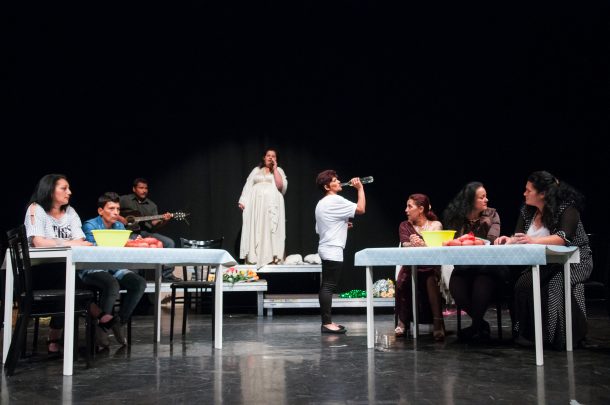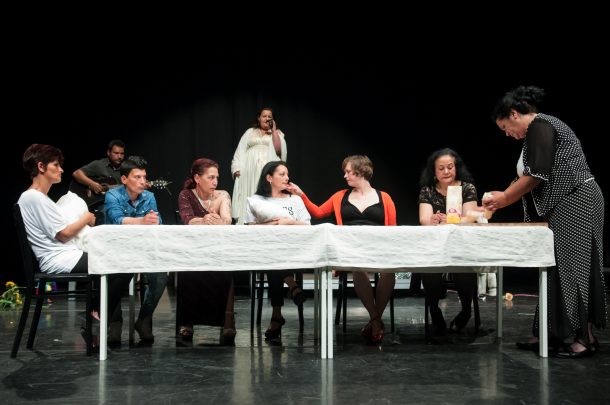The Trafó House of Contemporary Arts is one of the leading producers of experimental theatre work in Budapest. In May of 2017 it offered an unusual piece of documentary theatre, Long Live Regina!. The performers (bar one) were Romani women from Szomolya, a small village in the Hungarian countryside. From an aesthetic point of view the performance followed in the tradition of Germany’s Rimini Protokoll, putting everyday people as “experts”’ on the stage, but of greater importance from a Hungarian perspective it demonstrated the right of Romani women to represent themselves. The sociologists Kata Horváth and Marton Oblath, each with more than ten years of contact with this community, invited director Edit Romankovics and dramaturg Eszter Gyulay to participate in their artistic project. Central to the development of the play Long Live Regina! is the use of digital storytelling and psychodrama. Overall, the project has a therapeutic and community-building aspect, where the output as a theatrical production can be shown to a wider audience.
The play’s setting depicts a kitchen where eight women are preparing dishes while chatting. One of them is Lilla Sárosdi, familiar to Budapest audiences because of her performance there in Brecht’s Caucasian Chalk Circle. The others are Romani women between 35 and 45 years of age; their names are: Rita Horvath, Zsanett Horvath, Vali Kallai, Noemi Lakatos, Ilona Orgon and Judit Suha. From the advertising for the performance we are aware that they share many common points in their lives: they all left school early and became teenage mothers, and now work in a government employment scheme notorious for its bad working conditions. Still, from the first moments of the performance we are made aware how multifaceted Romani female identity is.

SelfTheatre, Long Live Regina!. Photo: Gabriella Csoszo.
At the back of the stage there is a small podium, where from time to time a woman in a white dress (Renata Bader) sings Romani songs accompanied by a musician. She takes the appearance of a mother goddess, and this impression is maintained during the performance when from time to time following a story the performers say, “Regina would have done things differently.” Preparation for the celebration of Regina’s birthday is the fictitious frame through which the women’s personal stories are told and performed. Such stories concern their dealings with the health and welfare system, and their humiliation and marginalization at the hands of doctors, midwives and social workers on the basis of racial prejudice. There are stories that end happily, such as the mother who fought successfully against the authorities taking her children to a children’s home. Others end harshly, such as the mother who took her milk daily to the hospital for her premature child, only to be told one day, without the least respect or empathy, that her child had died and that there was no need for her milk anymore. The woman who speaks in the penultimate scene describes the difficulty of raising a child in Hungary, the discrimination she faced when looking for a job, and her consequent decision not to bear a child in the near future. So even the decision to not have a baby is part of the picture.

SelfTheatre, Long Live Regina!. Photo: Gabriella Csoszo.
In verbatim theatre, besides the ethical burden of editing the text, it is also essential to focus the audience’s attention and avoid being boring (the so-called “talking heads” problem). In Long Live Regina! the music and the activity of cooking serve this practical function, since all the utensils and ingredients, even the electric oven, are real. The genre of the play’s songs is hallgató, which in Hungarian means both listening and being silent. These songs at once separate the stories and weave them together, providing emotional release and even, on occasion, relating directly to the story being told. The use of songs and music creates a patchwork effect, but the play also builds to its last and most profound story. Here, three women speak about being forcibly sterilized during caesarean delivery. This was carried out without their intention or will, and in one case without any notice of the fact that it had happened at all. At the beginning of this scene the lights dim to almost complete darkness; the women at the table are seen speaking to Lilla Sárosdi (into a microphone for the first and only time during the performance), showing only their backs to us. This creates a protected environment for them while they reveal their trauma. The ending of the performance hints at the potential for things to happen differently in the future. As the food is prepared, the room is decorated at last, and someone brings a birthday cake with candles to the table. But in the background, Regina (a goddess of another kind of reality), try as she may, can’t blow them out; it is a woman seated at the table who performs the task for her.

SelfTheatre, Long Live Regina!. Photo: Gabriella Csoszo.
In drama, performance, and art history, the kitchen and food preparation have often been the subjects of deconstruction in the last couple of decades, to the extent that cooking, singing and devotion to a mother goddess might appear a bit essentialist and passé nowadays. But things appear quite different in the context of the work of women artists of the nineteenth century. In this period, female painters who had the privilege of studying art and putting on exhibitions could not go to the same places as their male counterparts, so the topics they painted differed in terms of both subject and perspective. In the paintings of Mary Cassatt (as Griselda Pollock showed) women are in their own company, paying attention to each other; what is more, in The Bath (1890) class differences are made apparent in a gentle and intimate way without degrading the female body to an object of sexual commodification (as in the paintings of Degas).
Long Live Regina! displays a similar representational logic. Among the Romani women there is Lilla Sárosdi who is unique because of her constant intense (emotional and physical) self-revelation in her roles on stage. In Long Live Regina! not only does her presence and attention support the Romani women who lack formal acting experience, but she also tells her own story of an abortion and how she was humiliated by the doctor. “In this case we are all equal,” they suggest, but in other scenes the performers also reflect on their divergent backgrounds and class distinctions. By doing so Long Live Regina! speaks about gender roles in a way that articulates the racial and class differences of the maternal experience instead of assuming a universal one. This is totally new for the Hungarian stage.
Gabriella Schuller, PhD (1975) lives and works in Budapest, Hungary. She is a member of Theatre and Film Studies Committee of Hungarian Academy of Sciences and the author of many articles on contemporary Hungarian theatre, the performative practices of the Hungarian neo-avantgarde, visual studies, and performance art. Her book Iconoclasts. The Diversion of the Gaze in the Post/Feminist Theatre and Performances (2006) deals with the questions of a feminist approach to theatrical representation. Since 2016 she has been a researcher and archivist at Artpool Art Research Center, Hungary.
European Stages, vol. 10, no. 1 (Fall 2017)
Editorial Board:
Marvin Carlson, Senior Editor, Founder
Krystyna Illakowicz, Co-Editor
Dominika Laster, Co-Editor
Kalina Stefanova, Co-Editor
Editorial Staff:
Taylor Culbert, Managing Editor
Nick Benacerraf, Editorial Assistant
Advisory Board:
Joshua Abrams
Christopher Balme
Maria Delgado
Allen Kuharsky
Bryce Lease
Jennifer Parker-Starbuck
Magda Romańska
Laurence Senelick
Daniele Vianello
Phyllis Zatlin
Table of Contents:
- The 2017 Avignon Festival: July 6 – 26, Witnessing Loss, Displacement, and Tears by Philippa Wehle
- A Reminder About Catharsis: Oedipus Rex by Rimas Tuminas, A Co-Production of the Vakhtangov Theatre and the National Theatre of Greece by Dmitry Trubochkin
- The Kunstenfestivaldesarts 2017 in Brussels by Manuel Garcia Martinez
- A Female Psychodrama as Kitchen Sink Drama: Long Live Regina! in Budapest by Gabriella Schuller
- Madrid’s Theatre Takes Inspiration from the Greeks by Maria Delgado
- A (Self)Ironic Portrait of the Artist as a Present-Day Man by Maria Zărnescu
- Throw The Baby Away With the Bath Water?: Lila, The Child Monster of The B*easts by Shastri Akella
- Report from Switzerland by Marvin Carlson
- A Cruel Theatricality: An Essay on Kjersti Horn’s Staging of the Kaos er Nabo Til Gud (Chaos is the Neighbour of God) by Eylem Ejder
- Szabolcs Hajdu & the Theatre of Midlife Crisis: Self-Ironic Auto-Bio Aesthetics on Hungarian Stages by Herczog Noémi
- Love Will Tear Us Apart (Again): Katie Mitchell Directs Genet’s Maids by Tom Cornford
- 24th Edition of Sibiu International Theatre Festival: Spectacular and Memorable by Emiliya Ilieva
- Almagro International Theatre Festival: Blending the Local, the National and the International by Maria Delgado
- Jess Thom’s Not I & the Accessibility of Silence by Zoe Rose Kriegler-Wenk
- Theatertreffen 2017: Days of Loops and Fog by Lily Kelting
- War Remembered Onstage at Reims Stages Europe: Festival Report by Dominic Glynn
Martin E. Segal Theatre Center:
Frank Hentschker, Executive Director
Marvin Carlson, Director of Publications
Rebecca Sheahan, Managing Director
©2016 by Martin E. Segal Theatre Center
The Graduate Center CUNY Graduate Center
365 Fifth Avenue
New York NY 10016



